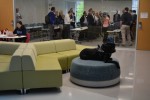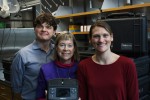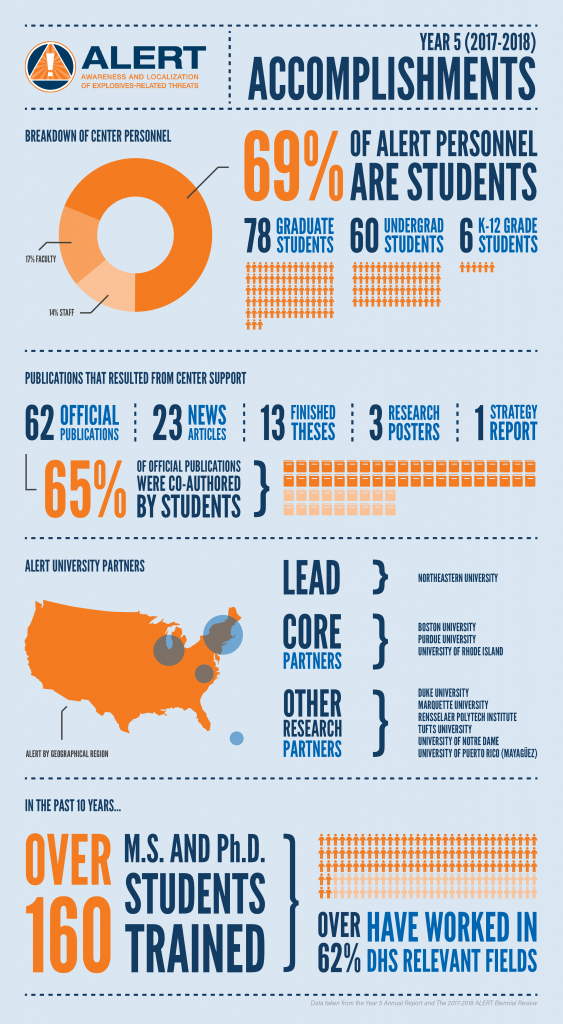News & Events
ALERT Program
ALERT Transitions to a DHS S&T Emeritus Center of Excellence December 16, 2021
For users without YouTube access: The ALERT Center Overview
As of spring 2021, ALERT transitioned to become an emeritus Department of Homeland Security (DHS) Science and Technology (S&T) Directorate Center of Excellence.
Since its founding in 2008, ALERT has conducted transformational research, developed technologies, and provided educational development to improve the effective characterization, detection, mitigation and response to explosives-related threats facing the country and the world. Throughout ALERT’s existence, we have worked with strategic partners Northeastern University, Boston University, Purdue University and the University of Rhode Island towards our goals of eliminating illicit explosives, improving on actionable tracing detection, raising the reliability of screening, increasing the accuracy of long distance stand-off discovery of threats and seamlessly transitioning research.
As an Emeritus Center of Excellence, ALERT will continue to conduct research and technology development on several Task Orders and will continue to organize the Advanced Development for Security Applications (ADSA) and the Customs and Border Protection – Advanced Developments Encompassing Processes and Technologies (CBP-ADEPT) workshop series.
In our latest video, ALERT Director Michael Silevitch discusses ALERT’s impact over the years, including but not limited to, the test beds and task orders that have been ushering ALERT technology into the field and into industrial partnerships.
Staff Spotlight: Deanna Beirne April 30, 2020

At ALERT, the work of our faculty, staff, and students is the epicenter of the continuous development of the characterization, detection, mitigation, and response to explosive related threats around the world. In this month’s newsletter, we interviewed ALERT staff member Deanna Beirne, our Senior Director of Research Computing and Technical Program Development to learn more about her work with ALERT.
Deanna, who has worked with ALERT since its inception in 2008, supports the center’s research mission in two key areas. First, her work assures that the multi-university center has a sufficient and robust information technology infrastructure for the work being performed. Secondly, and more recently, Deanna has been providing program management, testbed, and transition support to several of ALERT’s research projects, transition efforts and task orders.
Two of the major research initiatives that Deanna works on are the Correlating Luggage and Specific Passengers (CLASP) and Maturation and Validation of Dielectric Characterization Algorithms DHS Task Orders. CLASP uses advanced video analytics to evaluate data from CCTV security cameras in an effort to develop algorithmic software capable of automatically tracking passengers at airport security checkpoints and associating them with their luggage and items. This automated tracking will be useful to identify certain events within the checkpoint, like theft, or passengers forgetting items at the security checkpoint, while also logging how fast it takes passengers to go through the checkpoint. The Maturation and Validation of Dielectric Characterization Algorithms Task Order involves the development of an advanced passenger screening system used to differentiate between a detected item that could be a threat, like a body-borne explosive, or something benign – like a forgotten wallet. This system could increase security effectiveness and improve the passenger experience by reducing the number of pat-downs needed to resolve body scanner alarms.
Learn more about Deanna’s work with CLASP and Maturation and Validation of Dielectric Characterization Algorithms in the interview below.
As the Program Manager for CLASP, can you describe recent research developments and how this will impact next steps in the project?
Yes, a few months ago the researchers were able to benchmark their algorithms on a new video dataset collected at our Video Analytics Lab at the Kostas Research Institute. Built specifically for this project, the lab is configured with a CCTV camera grid, networked video recording system and a mock airport security checkpoint. The lab configuration leverages actual security checkpoint equipment donated to us by the TSA, Rapiscan and Smiths Detection.
To generate the video data we need for the project, we have volunteers act out scenarios which may occur in real life at an airport security checkpoint, and have the video cameras record them. At out last video data collection event, we had Transportation Security Officers, and even a service dog participate, adding another layer of realism to the video data the researchers have access to.
The performance results of the algorithms developed by the teams at Marquette University, Northeastern University, and Rensselaer Polytechnic Institute were good enough to begin merging the individual software components together, which is the next step in creating a real-time system.
What ongoing challenges have there been with CLASP research?
First, every airport is uniquely configured with completely different layouts and physical constraints. This makes it difficult to find a solution that will work for all checkpoints. Given these limitations, it has been extremely beneficial to speak directly with security stakeholders and visit various airports to get input on a solution that can work across a variety of configurations, while leveraging existing airport infrastructure and remaining cost-effective.
Second, getting video data that can be used to test and improve the algorithms has been a challenge as well. Humans are incredibly good at looking at imagery and interpreting what is present or happening in a photo or video; computer algorithms are getting better, but it takes a lot of work to get them to do what people can do. The algorithms need to be trained to correctly interpret the actions and objects you want the algorithm to understand. This, as anyone can imagine, requires a lot of data that we collect in both lab and live environments. The lab is used to generate specific scenarios that may not occur frequently at live checkpoints. We then need to test and train those same algorithms on video data collected at actual airport checkpoints. Using actual footage from real checkpoints will assure CLASP will be effective in a live airport deployment.
You also provide program management for ALERT’s DHS task order focused on the maturation of dielectric characterization algorithms and a partnership with Astrophysics, Inc. to develop 3D reconstruction algorithms. Can you explain what those projects are and their expected deliverables?
The Dielectric Characterization project is funded by the DHS S&T Screening at Speed program and is led by Prof. Carey Rappaport, ALERT’s Deputy Director. The work focuses on taking data collected by a next-generation Advanced Imaging Technology (AIT) screening system, one similar to what you pass through in the airport security checkpoint, and determining if a detected item is something that might be a threat, like a body-borne explosive, or not, like a forgotten wallet. In order to do this, the team is developing software to evaluate the response of the millimeter waves transmitted by the system when they come into contact with an object on the body. From this response, the software can derive the dielectric constant of the object and determine if it is a potential threat, requiring a pat-down, or not.
ALERT was approached by Astrophysics, Inc. when it began developing its Multi-View Computed Tomography Cargo System. Astrophysics created a scanning system that was groundbreaking in its sensor array and scanning methods, but they were in need of a method to convert the 2D computed tomography (CT) X-ray images of shipping pallets that the system generated into clear 3D reconstructions of the pallets. ALERT had realized prior success in the CT reconstruction domain from the DHS funded CT-EDS Reconstruction Initiative and leveraged ALERT researchers such as Prof. David Castanon(BU), Prof. W. Clem Karl(BU), Prof. David Kaeli(NU), and Fernando Quivera PhD, to work on this new problem presented by Astrophysics, Inc. The work has proven very successful and the developed system is currently deployed at JFK airport.
How do all three of the projects that you describe change the screening process in their respective arenas?
The Dielectric Characterization project will help to enhance the detection capabilities of scanning systems, thereby minimizing the number of pat-downs or secondary inspections that have to be done on passengers. By minimizing the number of pat-downs at a checkpoint, it improves the passenger experience and makes the checkpoint line move faster. The 3D image reconstruction developed for the Astrophysics MVTC system makes imaging of cargo clearer and faster – it helps automate a process which is very manual right now. The CLASP program will help to bring in-line, risk-based screening to the airport security checkpoint. Our goal in all of these projects is to make security screening faster, smarter, and less intrusive – both for passengers and DHS components, like TSA and CBP, who rely on them.
When asked what is the most interesting part of her role, “being a part of research projects that are working on ground-breaking methods for advancing security technologies,” is a highlight for her. As a program manager, her work ensures that ALERT research is transferred into real-world solutions.
“The problems we work on as a center are complex and continue to evolve. Figuring out solutions for those problems, such as – are we able to tell if an object on a person is a threat without a pat-down; can we develop 3D image reconstructions that are detailed enough that a pallet of cargo doesn’t have to be unpacked to be inspected; can we leverage video technologies to make the airport security line faster and more efficient – are challenging, and that makes them exciting to work on” she said.
In addition, to her work with ALERT, Deanna volunteers for Boston-area art organizations like the Boston Center for the Arts and enjoys hiking with her border collie.
ALERT Hosts Technology Showcase & ADSA20 Workshop May 29, 2019

May 29, 2019
Earlier this month, the ALERT Center of Excellence hosted the ALERT Technology Showcase (May 14th) in conjunction with the ADSA20 Workshop (May 15th & 16th) at Northeastern University. The ALERT Technology Showcase featured presentations, posters, and technology demonstrations of the Center’s research and tools and highlighted the Center’s collaborative work with industry and government stakeholders, such as Astrophysics, Inc., DetectaChem, ENrG Inc., Pendar Technologies, Lawrence Livermore National Laboratory, Quadridox, Rapiscan Systems, Signature Sciences, and Smiths Detection, to name a few. The objective of the event was to demonstrate the transition of ALERT’s work to Department of Homeland Security components, such as the Transportation Security Administration and U.S. Customs and Border Protection, as well as its impact on the homeland security enterprise as a whole.
The twentieth workshop for Advanced Development for Security Applications (ADSA20) addressed the theme of “design, development, testing, deployment, and operation of effective systems.” Specific topics that were discussed during the workshop included: defining effective, effectiveness for stakeholders (airlines, passengers) and venues (subway, rail, cargo), humans in the loop, applications of metadata, rapid response to an adapting adversary, the role of artificial intelligence, and the transition of technology from academia to industry.
More than 160 attendees from academia, industry, and government participated in the ALERT Technology Showcase and ADSA20 Workshop, resulting in two of the most engaging events ALERT has hosted yet.
Regarding the value of the ALERT Technology Showcase, Francois Zayek, CEO of Astrophysics, Inc. stated
“I’m pleased to be here. I’m happy to see all the presentations, because again, we are so much involved in our industry. We are so much involved in the business, that we keep ourselves a little bit further away from the technologies, so every now and then it would be very helpful—and healthy—to come in and then see what is happening in the technology arena.”
Professor David Castañón (Boston University) and the lead for ALERT’s research on Video Analytics and Signature Analysis (Thrust R4), shared his thoughts on the most valuable aspect of the event stating
“It’s getting the feedback from a potential user. That is somebody who says ‘I have a problem this would be useful for.’ I’ve had two or three of those interactions while I have been here with the posters and it has been very nice.”
The next event ALERT will be hosting is the second workshop on Advanced Developments Encompassing Processes and Technologies for Customs and Border Protection (CBP-ADEPT-02), which will be held July 17th and 18th at Northeastern University. For more information on upcoming events and workshops, visit the ALERT website: www.northeastern.edu/alert
Photo: K9 Figaro waits patiently to participate in a demo of TEAS (Trace Explosives Aids for Scent), which ALERT developed in collaboration with DetectaChem, and showcased at the recent ALERT Technology Showcase as an example of safer training aids for explosives detection canines and first responders.
ALERT Researchers Awarded Patent May 29, 2019

May 29, 2019
ALERT researchers, Professor Carey Rappaport and Professor Jose Martinez-Lorenzo of Northeastern University were awarded a patent for an “On-the-Move Millimeter Wave Interrogation System with a Hallway of Multiple Transmitters and Receivers” on May 21, 2019.
In conventional screening systems that use radar imaging for surveillance and detection purposes, an object of interest may be illuminated (using millimeter wave) and the scattered field measured and processed to reconstruct a feature of the object. These systems may generate an image that profiles a detectable shape, outline and/or movement of an object or subject; however, conventional radar systems, such as a portal-based system, constrains a subject from movement. Professor Rappaport and Professor Martinez-Lorenzo’s patented solution allows for screening an unconstrained subject, meaning an individual could be scanned for foreign objects attached to their bodies (such as explosives and weapons hidden under clothing) as they moved through a hallway of transmitters and receivers. Such a system could lead to faster and more accurate screening of individuals as they make their way through security checkpoints.
Read more about the “On-the-Move Millimeter Wave Interrogation System with a Hallway of Multiple Transmitters and Receivers” patent here.
To learn more about the work Professor Rappaport and Professor Martinez-Lorenzo are doing to make screening for explosives and weapons more effective and efficient, visit their respective project pages: Projects R3-A.2 and R3-A.3, and Project R3-B.1.
ALERT’s Newest Industrial Members: 908 Devices and Rigaku Analytical Devices May 29, 2019

May 29, 2019
This spring, the ALERT Center of Excellence welcomed 908 Devices and Rigaku Analytical Devices as the Center’s newest industrial members thanks to their generous donations of equipment to further ALERT research efforts at the University of Rhode Island (URI).
908 Devices is a fast-growing business in Boston, Massachusetts that develops products ranging from rugged, handheld chemical detection tools to compact, tiny footprint analyzers and fast separation devices. These purpose-built and user-centric devices serve a range of industries including field forensics, oil and gas, life sciences, and other applied markets.
908 Devices donated twenty M908TM portable mass spectrometers to the Chemistry Department at URI to support the high school education programming run by Dr. Jimmie Oxley (ALERT Research Thrust 1 Lead) and Dr. James Smith (ALERT Education Program Co-Lead).The M908TM is the company’s first product based on their patented and proven high-pressure mass spectrometryTM. M908TM is currently being used by CBRNE and HAZMAT organizations around the world for chemical detection, with at least one M908TM device deployed in every state across the United States.
Rigaku Analytical Devices is a leading pioneer and innovator of handheld and portable spectroscopic analyzers for use in the protection of public health and safety, aid in the advancement of scientific and academic study, enable the recycle and reuse of metal alloys, and ensure quality of key metal alloy components in mission-critical industries. Their advanced and rugged products deliver unparalleled accuracy and extensive application support, empowering their customers to achieve rapid lab-like results any time, any place.
Rigaku Analytical Devices donated a KT-100STM alloy analyzer (handheld laser induced breakdown spectroscopy technology) to Dr. Oxley’s lab at URI.
ALERT industrial membership has several advantages. Through various events, ALERT provides members the opportunity to network with other industrial members, faculty from ALERT’s partner institutions, and representatives from local, state, and federal governments. Other advantages of ALERT industrial membership include admission to two exclusive members-only events: The Annual Student Pipeline Industry Roundtable Event (ASPIRE), which provides industrial members with access to qualified job-seeking students; and the ALERT Industrial Advisory Board meeting, which features engaging guest speakers, highlights of successful government-industry-academia collaboration, and networking opportunities. Members also have the opportunity to request targeted research in an area of interest to their organizations. As an added bonus, registration fees are waived for industrial members attending ALERT’s public workshops, such as the ADSA Workshop and CBP-ADEPT Workshop series.
For more information on the advantages of ALERT industrial membership, please see the Benefits of Collaboration, or contact our Industrial and Government Liaison Officer, Ms. Emel Bulat at [email protected], or our Industry Liaison Associate, Ms. Kristy Provinzano at [email protected].
Rigaku Analytical Devices: ALERT’s Newest Industrial Member May 7, 2019
May 9, 2019
ALERT is pleased to welcome Rigaku Analytical Devices as its newest industrial member thanks to their donation of a KT-100S alloy analyzer (handheld LIBS technology) to Dr. Jimmie Oxley (ALERT Research Thrust 1 Lead) at the University of Rhode Island.
Rigaku Analytical Devices is a leading pioneer and innovator of handheld and portable spectroscopic analyzers for use in the protection of public health and safety, aid in the advancement of scientific and academic study, enable the recycle and reuse of metal alloys, and ensure quality of key metal alloy components in mission-critical industries. Their advanced and rugged products deliver unparalleled accuracy and extensive application support, empowering their customers to achieve rapid lab-like results any time, any place.
ALERT industrial membership has several advantages. Through various events, ALERT provides members the opportunity to network with other industrial members, faculty from ALERT’s partner institutions, and representative from local, state, and federal governments. Other advantages of ALERT industrial membership include admission to two exclusive members-only events: The Annual Student Pipeline Industry Roundtable Event (ASPIRE), which provides industrial members with access to qualified job-seeking students; and the ALERT Industrial Advisory Board meeting, which features engaging guest speakers, highlights of successful government-industry-academia collaboration, and networking opportunities. Members also have the opportunity to request targeted research in an area of interest to their organizations. As an added bonus, registration fees are waived for industrial members attending ALERT’s public workshops, such as the ADSA Workshop and CBP-ADEPT Workshop series.
For more advantages of ALERT industrial membership, please see the Benefits of Collaboration, or contact our Industrial and Government Liaison Officer, Ms. Emel Bulat at [email protected], or Ms. Kristy Provinzano at [email protected].
908 Devices: ALERT’s Newest Industrial Member April 8, 2019

March 28, 2019
ALERT is pleased to welcome 908 Devices as its newest industrial member thanks to their generous donation of 20 M908TM portable mass spectrometers to the University of Rhode Island Chemistry Department to support the high school education programming run by Dr. Jimmie Oxley (ALERT Research Thrust 1 Lead) and Dr. James Smith (ALERT Education Program Co-Lead).
908 Devices is a fast-growing business in Boston, Massachusetts that develops products ranging from rugged, handheld chemical detection tools to compact, tiny footprint analyzers and fast separation devices. These purpose-built and user-centric devices serve a range of industries including field forensics, oil and gas, life sciences, and other applied markets. The M908 is the company’s first product based on their patented and proven high-pressure mass spectrometryTM. . M908 is currently being used by CBRNE and HAZMAT organizations around the world for chemical detection, with at least one M908 device deployed in every state across the United States.
ALERT industrial membership has several advantages. Through various events, ALERT provides members the opportunity to network with other industrial members, faculty from ALERT’s partner institutions, and representative from local, state, and federal governments. Other advantages of ALERT industrial membership include admission to two exclusive members-only events: The Annual Student Pipeline Industry Roundtable Event (ASPIRE), which provides industrial members with access to qualified job-seeking students; and the ALERT Industrial Advisory Board meeting, which features engaging guest speakers, highlights of successful government-industry-academia collaboration, and networking opportunities. Members also have the opportunity to request targeted research in an area of interest to their organizations. As an added bonus, registration fees are waived for industrial members attending ALERT’s public workshops, such as the ADSA Workshop and CBP-ADEPT Workshop series.
For more advantages of ALERT industrial membership, please see the Benefits of Collaboration, or contact our Industrial and Government Liaison Officer, Ms. Emel Bulat at [email protected], or Ms. Kristy Provinzano at [email protected].
Making Connections at ASPIRE 2019 March 27, 2019

March 28, 2019
This week, STEM students from ALERT’s academic partner institutions, and representatives from ALERT’s Industrial Members and government collaborators gathered together at Northeastern University for the Annual Student Pipeline Industry Roundtable Event (ASPIRE 2019). The aim of the ASPIRE series is to connect members of the industrial and government communities with qualified STEM students looking for internships, co-ops, and full-time jobs related to homeland security.
ASPIRE 2019 kicked off with welcoming remarks from Michael Silevitch (Director, ALERT), Emel Bulat (Senior Consultant for Corporate & Government Partnerships, ALERT), and Kristy Provinzano (Industry Liaison Associate, ALERT). Following this, ALERT Industry Members (American Science & Engineering, Rapiscan Systems, Raytheon, Smiths Detection) and representatives from the Department of Homeland Security and the U.S. Customs & Border Protection introduced student career opportunities at their respective organizations.
According to Adam Hutter, Laboratory Director at U.S. Customs and Border Protection’s New York Laboratory, “We’re constantly hiring, so we want to make sure we’re bringing in the best talent we can. The Department of Homeland Security has already invested heavily in these students through the Centers of Excellence pipeline, so it’s a resource we should utilize. These students have a leg up, because they’re already working on homeland security problems.”
ASPIRE 2019 featured both group and one-on-one meetings between students and representatives from industry and government. Many of the participants, like Jose Ruiz-Caballero who works on ALERT Project R3-C at the University of Puerto Rico Mayaguez, were ASPIRE returnees interested in jobs: “It’s a high impact event from my professional point of view, because you have direct contact with industry and government and they can provide you with a profile of what they’re looking for in a candidate.”
Molly Baldwin, a Purdue University undergraduate who works on ALERT Project R2-A.3 and is about to graduate is looking toward the future: “I started working on the research project last semester and fell in love with this industry. I’m here to see what jobs are out there for chemical engineers. I could see myself continuing to do research to improve the detection of explosives.”
For other students, the event is a great networking opportunity and a chance to gain experience speaking with job recruiters. First year student and first time ASPIRE attendee, Ian Hay, who does breast cancer detection research at Northeastern University, isn’t looking for a job quite yet, but found the event to be beneficial. According to Hay, “Communicating with different companies, both public and private, is valuable to me, especially in a low-pressure setting. Being able to meet with representatives and explain my work and how it applies to their industry is great practice.”
Since its establishment as a DHS Center of Excellence, ALERT has prioritized training the next generation of professionals to tackle explosives-related threats. Over the past 12 years, ALERT has trained over 160 graduate students, resulting in more than 100 of these professionals working in DHS-relevant fields. Events like ASPIRE 2019 are a significant part of ALERT’s mission to provide educational development to improve effective characterization, detection, mitigation and response to explosives-related threats facing the nation and the world.
Infographic: ALERT’s Year 5 (2017-2018) Accomplishments January 29, 2019
January 29, 2019
As we begin the New Year, we are also looking back on the previous year! Check out our newest infographic on ALERT’s Year 5 (2017-2018) Accomplishments.
ALERT Researchers Selected as IEEE Fellows January 29, 2019

January 29, 2019
Please join us in congratulating the newly elevated IEEE Fellows for the Class of 2019! We are especially proud of ALERT researchers Mario Sznaier of Northeastern University, and David Castañón and Venkatesh Saligrama of Boston University for this significant achievement. IEEE Fellow is a distinction reserved for select IEEE members whose extraordinary accomplishments in any of the IEEE fields of interest are deemed fitting of this prestigious grade elevation. The total number selected in any one year does not exceed one-tenth of one percent of the total voting IEEE membership.
Mario Sznaier is a Northeastern University ECE Professor and co-leads ALERT Project R4-A.1. Sznaier has been elevated to an IEEE Fellow for his contributions to identification of switched systems and multiobjective control. His work on Project R4-A.1 aims to substantially enhance our ability to exploit surveillance camera networks to predict and isolate threats from explosive devices in heavily crowded public spaces, and to guide complementary detection modalities, subsequent to a threat alert.
David Castañón and Venkatesh Saligrama are Boston University ECE Professors and collaborators on ALERT Project R4-A.2. Castañón has been elevated to an IEEE Fellow for his contributions to discrete-time stochastic control and information fusion. Saligrama has been elevated to an IEEE Fellow for his contributions to distributed detection and estimation of structured signals. Their work on Project R4-A.2 aims to leverage machine learning and computer vision methods for surveillance over multi-camera networks and to develop methods that are capable of real-time and forensic detection of suspicious activity.

